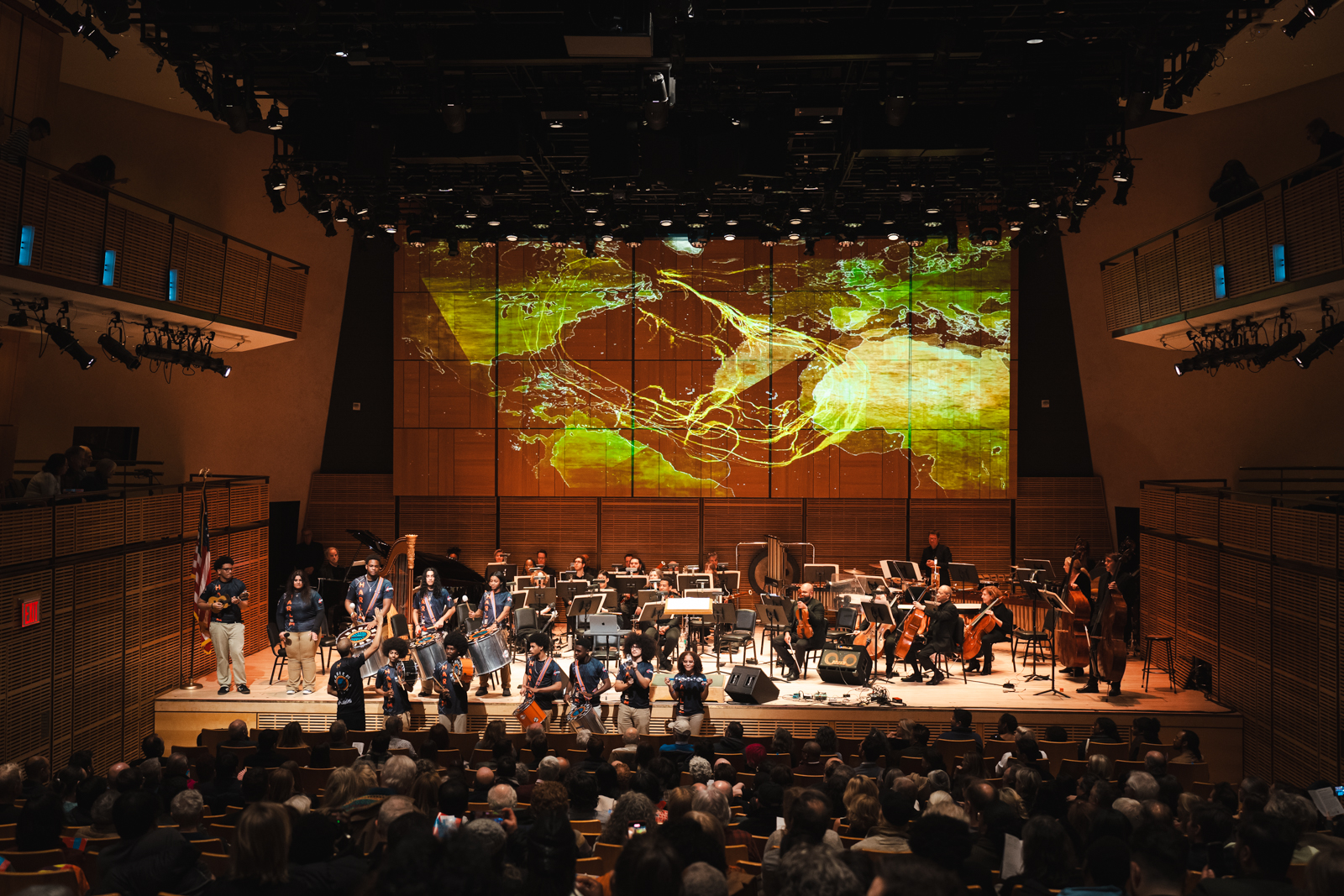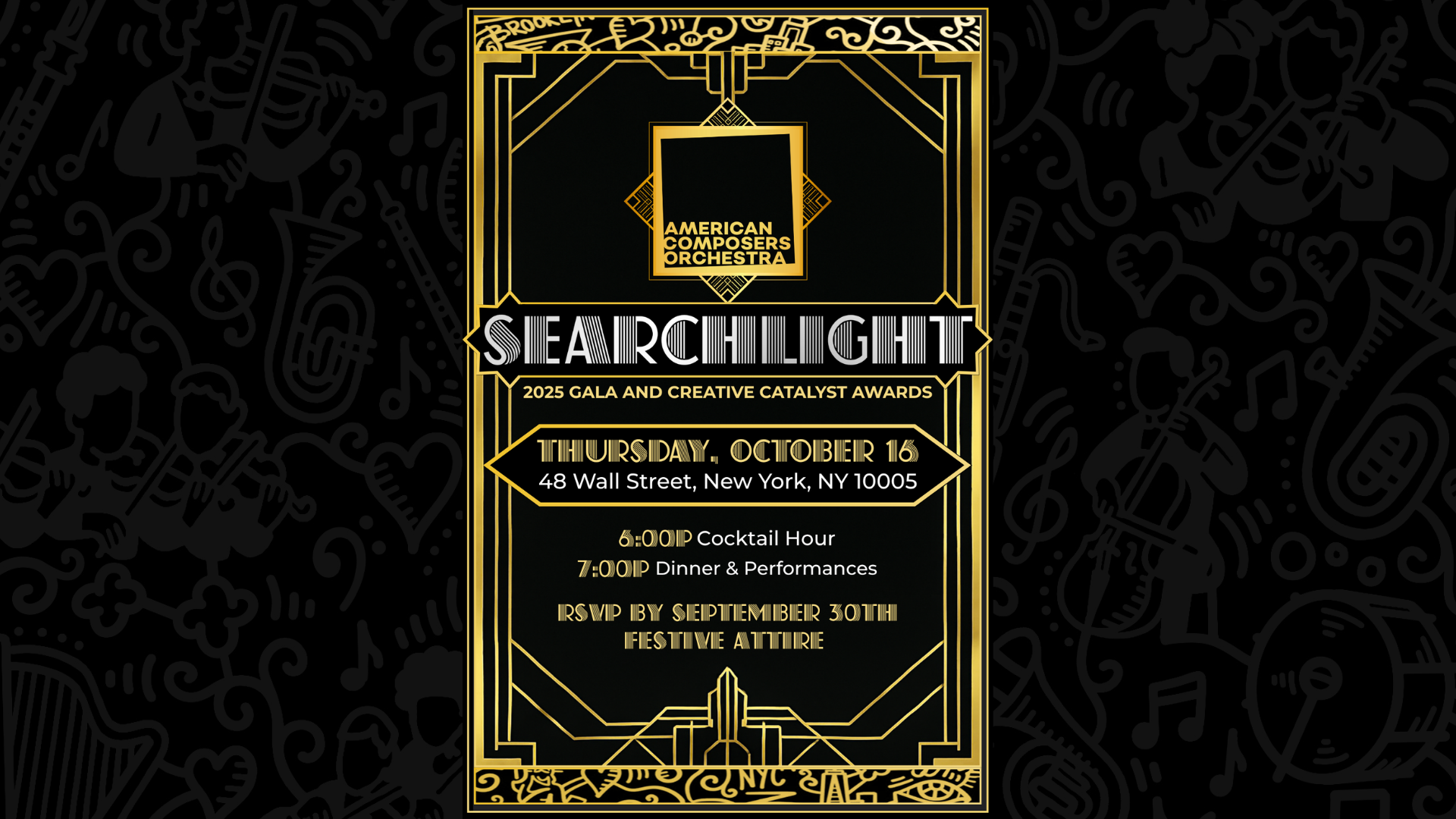Earshot Education Modules

Welcome to the EarShot Education Modules, a collection of curricular resources and performance-ready orchestral works by living composers.
These tools are designed specifically for educators working with youth orchestras, college ensembles, and high school musicians, and offer meaningful ways for students to engage with contemporary music through identity-based inquiry, creative composition, and intentional listening.
What is EarShot Publishing?
Launched by the American Composers Orchestra in 2024, EarShot Publishing is a groundbreaking initiative that supports composers from traditionally underrepresented backgrounds by publishing and distributing orchestral works developed through ACO’s national composer advancement program, EarShot. Through this initiative, ACO has partnered with Boosey & Hawkes, an international leader in classical music publishing, to administer the EarShot Publishing catalog worldwide.
As part of the publishing initiative, our composers have also developed scores that are suitable for youth orchestras. You can find these available for rental or purchase by navigating to the bottom of this page, and select the composer whose work you wish to explore. Each Youth Orchestra score comes with a ready-to-use module that will guide your students through creatively and emotionally connecting with the work.
What are the EarShot Education Modules?
EarShot Education Modules are dynamic teaching resources designed to help orchestras, classrooms, and communities connect with the music of living composers. Each module centers the composer’s voice, creative process, and social context, engaging students with their own identity and lived experience to impact their playing.
These guides are long form slide-show presentations that can be completed in a long rehearsal or class period, or split over multiple days. Whether you’re leading a youth orchestra, teaching a high school ensemble, or guiding a classroom of curious listeners, you’ll find ready-to-use tools to implement in your classroom and unlock your student's creativity, improvisation, musical instincts, compassion, and empathy.
Our initiative has developed two types of modules:
Youth Orchestra Performance Modules
Each performance module is designed to accompany a youth orchestra version of an orchestral work by a living composer. These guides will challenge your students to deepen their connection to the music they play.
These guides help conductors and ensemble educators:
- Understand the composer’s vision and musical language
- Connect students to the piece through creative inquiry, improvisation, and personal reflection
- Build technical and ensemble skills that directly support a successful performance
- Engage students in identity-based explorations of the themes and ideas behind the piece
Why it works: When students see themselves and their histories reflected in the music they perform, their motivation, curiosity, and musicianship flourish.
Classroom Listening Modules
Not every class can perform a new orchestral work, but every student can hear one. These interdisciplinary guides are perfect for academic and music classrooms, or preparatory work before attending a concert.
Listening guides are built to:
- Introduce students to contemporary composers and their musical voices
- Spark creative discussion around the social, cultural, and historical contexts of each piece
- Use identity-based inquiry to connect music to students’ lived experience
- Link to other academic disciplines such as history, literature, science, and more
Why it works: Listening becomes an act of empathy, self-discovery, and creativity. No instruments required, just curious ears and open minds.
Available Modules
Youth Orchestra Performance
Kebra Seyoun-Charles
This module provides an introduction and invites student musicians to explore the art of improvisation through Kebra-Seyoun Charles’ Counterclassical Treatise. Using familiar traditional forms of embellishment as an introduction, such as trills and mordants, students are guided from adding simple ornamentation to an existing melody, to expanding those ornaments into short original phrases, to improvising freely within the context of the piece. Students will explore how their individual sense of ornamentation (or “style”) is connected to their personal history and identity and they will explore how artists from a variety of genres express their history and identity in the ways that they add ornamentation to their own music. This module encourages students to go beyond technical execution, fostering a deeper connection to the music by allowing their creativity to shape the piece in real-time while bringing their own personal styles and ideas into the room.
inti figgis-vizueta
This module invites student musicians into the powerful sound world of inti figgis-vizueta’s seven sides of fire. Drawing on init’s Quechua heritage, this piece is inspired by the stages of a controlled burn and Indigenous land stewardship practices . As students explore each movement, they’ll use graphic notation as a creative launchpad, transforming cell-based notated prompts into improvised musical experiences. Through guided improvisation on the sounds of igniting, burning, and regrowth, students will experiment with sound, connect with their peers, and reflect on how identity, environment, and cultural traditions can shape music-making. Along the way, they’ll learn about ecological balance, co-creation, improvisation, and how fire itself can be a source of renewal and transformation.
Joseph C. Phillips
Set against the backdrop of Black leisure during the Jim Crow era, The Great Silence explores themes of rest, resilience, and cultural memory. In this module, students will connect with the historical narrative behind the piece—examining Black-owned resorts as spaces of joy and resistance—while refining ensemble techniques for interconnected rhythms, using modes to create melodies, and using other songs as musical inspiration for a composition. Activities guide students through creative interpretation of landscape and tranquility to create soundscapes, historical inquiry of the Jim Crow era, and personal reflection on relaxation and peace, helping them connect their own experiences to the music’s emotional and social resonance
Horacio Fernández
This module ignites the energy of salsa, bachata, and reggaetón in the orchestra. Students explore Latin rhythms through movement, listening, and performance as they dive into Horacio Fernández’s Tumbao. Alongside musical practice, students learn about the Afro-Caribbean roots of these genres, the instruments that define them, and the cultural histories they carry. Through playful, hands-on activities and engaging videos created by the composer, students will discover the rhythm of the clave, and explore how Latin music is built on the heartbeat of the rhythm section. Activities invite students to connect the rhythms of Tumbao to their own lived experiences and communities, creating a rich blend of technical growth and cultural exploration. Students are encouraged to investigate the rhythms of Tumbao in their own lived experiences and communities, to cultivate a rich blend of technical growth and cultural exploration.
Button TextMichael R. Dudley Jr.
This module invites students into a sound world shaped by questions of belonging, conflict, and spiritual searching. Through creative activities and discussion, students explore how composers like Michael Dudley Jr. use contrast between calm and chaotic, and consonance and dissonance to express complex emotional landscapes. Students will improvise and compose short musical motifs, experiment with harmony and dissonance, and learn more about the sonic power of dynamics to broaden their expression and connection with the music. This module goes beyond technical execution, encouraging students to bring their emotionality, musicality, and imagination to the ensemble experience. Discussions will reflect on identity, connection, and the emotional landscapes embedded in Michael Dudley Jr.’s A Heretic’s Prayer.
Classroom Listening
Brittany J. Green
Sampling becomes a window into identity, memory, and history in this exploration of Brittany J. Green’s Rencontres. Students will build a collaborative sample library using sounds from their daily lives to create mini-compositions that reflect their own personal narratives. They’ll explore abstraction, emotion, and sound as language, investigating how a single word or memory can transform into music. This module initiates a deeper understanding of orchestral composition as a tool for connection: to self, to peers, and to the long tradition of innovation in hip-hop and soul music.
Alyssa Regent
This module invites students with or without musical background to sharpen their powers of observation and reimagine the world around them as a source of creative inspiration. Through listening and sonic exploration, students will investigate the everyday sounds that surround them at school, at home, and in nature. Drawing on Where Even Shadows Are Light by Alyssa Regent’s, they’ll learn how the composer draws on both her connection to the natural world and the curiosity of scientific inquiry to shape sound into story. Students will build original soundscapes rooted in their environment and personal experience, exploring how imagination, identity, and attentive listening can transform the familiar into something extraordinary.























.avif)